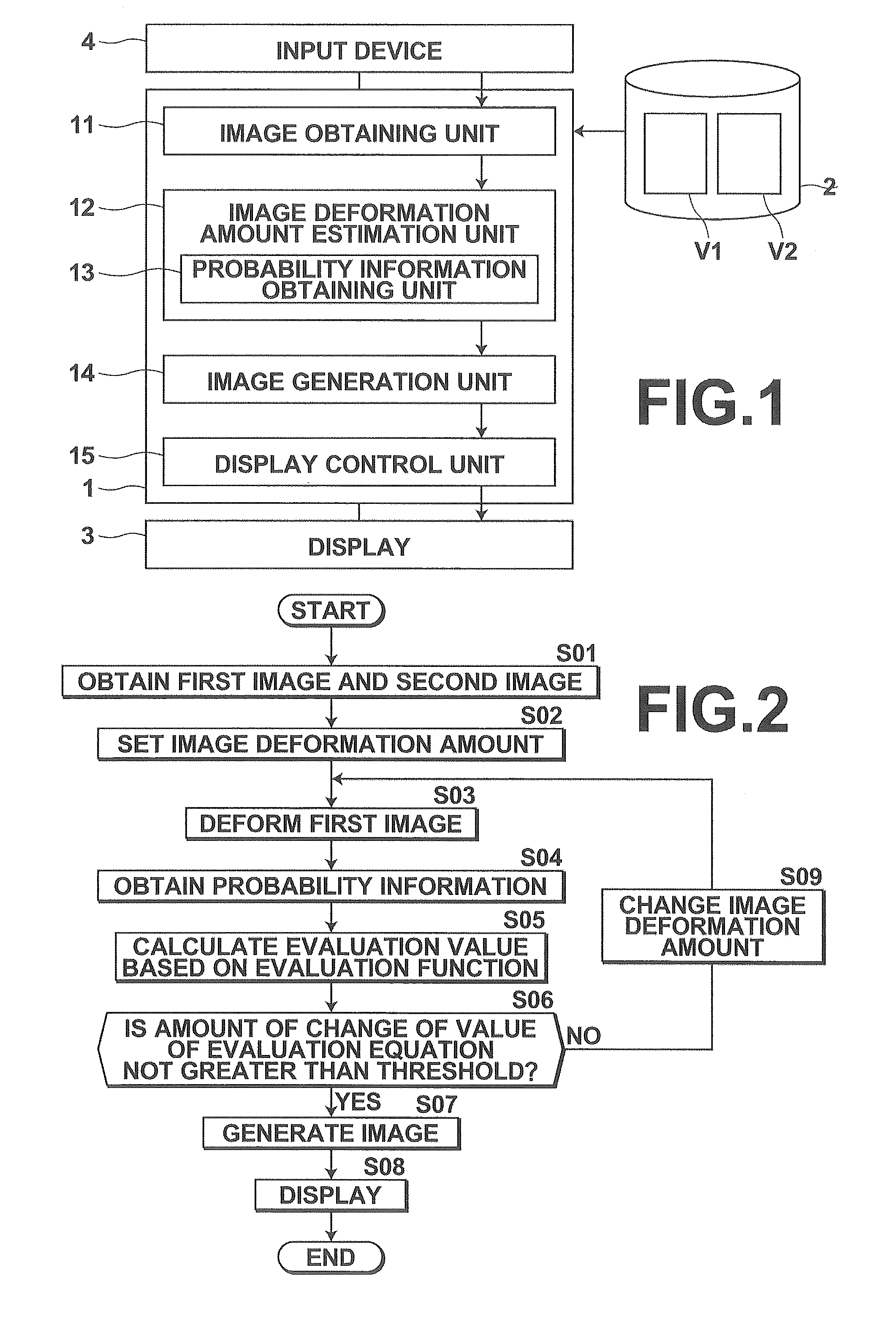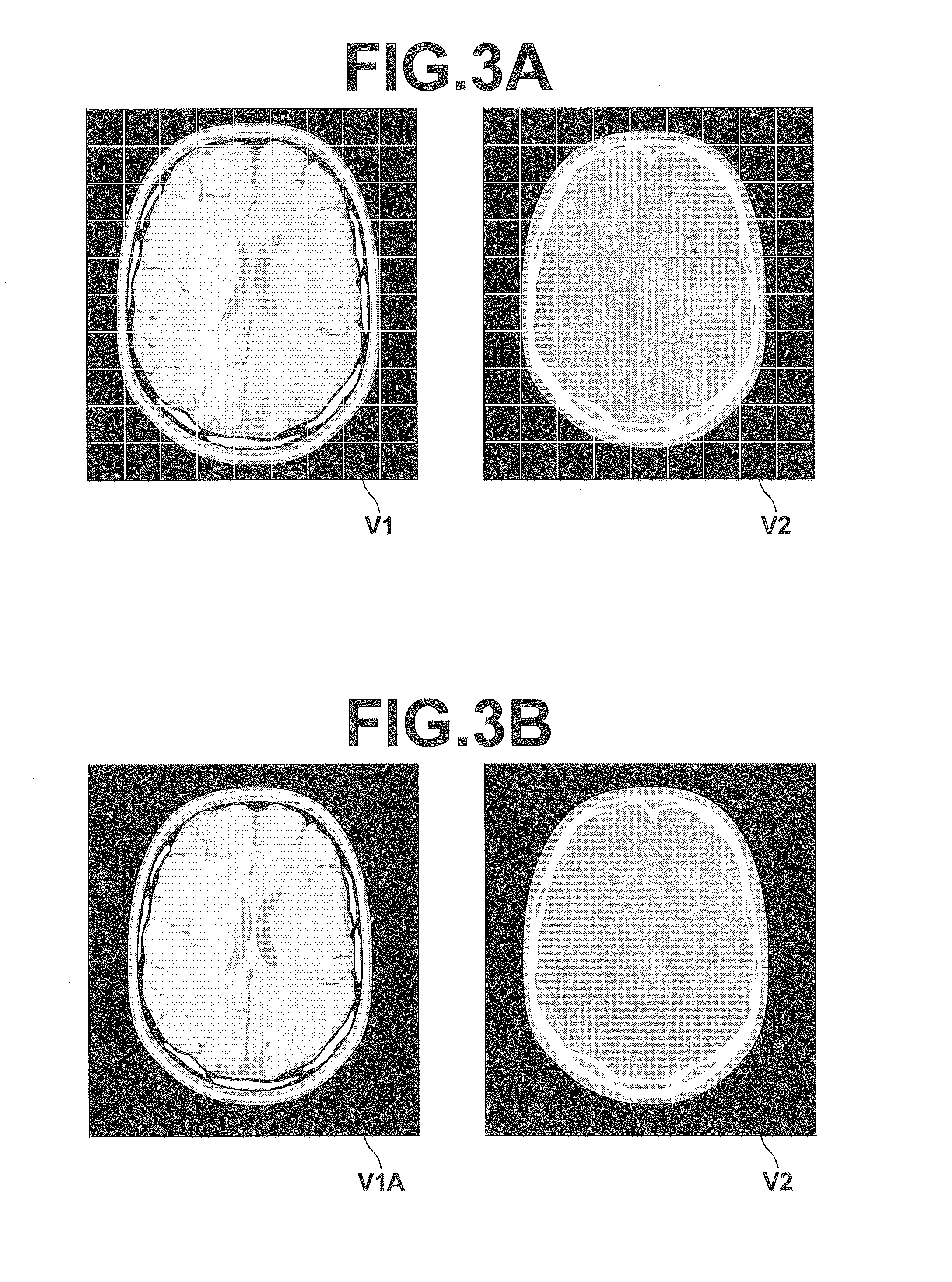Image processing device, image processing method and image processing program
a technology of image processing and image deformation, applied in the field of image processing device, image processing method and image processing program, can solve the problem of not being able to register between the deformed image and the other image, and achieve the effect of accurate estimation of the amount of image deformation and more correct evaluation of similarity
- Summary
- Abstract
- Description
- Claims
- Application Information
AI Technical Summary
Benefits of technology
Problems solved by technology
Method used
Image
Examples
first embodiment
[0045]In this first embodiment, the image deformation amount estimation unit 12 evaluates the similarity between the deformed first image V1a and the second image V2 using the evaluation function S(μ), which is expressed by Equation (3) described later. According to the evaluation function S(μ) in this embodiment, the higher the similarity between distributions of pixel values of the deformed first image V1a and the second image V2, the greater the value of the evaluation function S(μ). Therefore, the image deformation amount estimation unit 12 determines, with changing the image deformation amount μ, an image deformation amount μ that makes an amount of change of the evaluation function S(μ) (or an absolute value of a partial derivative ∇S(μ) with respect to μ) be not greater than a predetermined threshold value as an image deformation amount that achieves the maximum value of the similarity between the two images (an image deformation amount that achieves the highest similarity be...
second embodiment
[0086]The image deformation amount estimation unit 12 in the second embodiment uses, as a term representing a measure of correlation between a pixel value m;μ of the deformed first image V1a and a pixel value f of the second image V2 (i.e., the term representing a measure of correlation) in the evaluation function SD, a term representing a difference (which may hereinafter be referred to as “difference A”) between the joint probability distribution function p(f, m;μ) with a pixel value m;μ of the deformed first image V1a and a pixel value f of the second image V2 being discrete probability variables and the probability information PL(m;μ|f). Hereinafter, the evaluation function (which uses, as the term representing a measure of correlation, the evaluation function using the term representing the difference A) may be referred to as “second evaluation function”.
[0087]In this embodiment, the difference A is defined as a Kullback-Leibler distance (KL distance) between the joint probabil...
third embodiment
[0099]The first evaluation function and the second evaluation function in the third embodiment are introduced in the evaluation function such that the similarity is evaluated as higher similarity when the similarity between the deformed first image and the second image is higher. For example, a weighted sum of the first evaluation function and the second evaluation function can be used as the evaluation function.
[0100]In this embodiment, the evaluation function is defined as a weighted sum of the first evaluation function S(μ) and the second evaluation function SD(μ) as expressed by Equation (10):
S(μ)−λSD(μ) (10).
In Equation (10), λ is a weighting factor that is set as appropriate depending on the condition.
[0101]FIG. 7 is a flow chart illustrating the flow of image processing in the third embodiment. Now, the third embodiment is described according to FIG. 7.
First, similarly to the first embodiment, the image obtaining unit 11 obtains the first image (first image data) V1 and the ...
PUM
 Login to View More
Login to View More Abstract
Description
Claims
Application Information
 Login to View More
Login to View More - R&D
- Intellectual Property
- Life Sciences
- Materials
- Tech Scout
- Unparalleled Data Quality
- Higher Quality Content
- 60% Fewer Hallucinations
Browse by: Latest US Patents, China's latest patents, Technical Efficacy Thesaurus, Application Domain, Technology Topic, Popular Technical Reports.
© 2025 PatSnap. All rights reserved.Legal|Privacy policy|Modern Slavery Act Transparency Statement|Sitemap|About US| Contact US: help@patsnap.com



